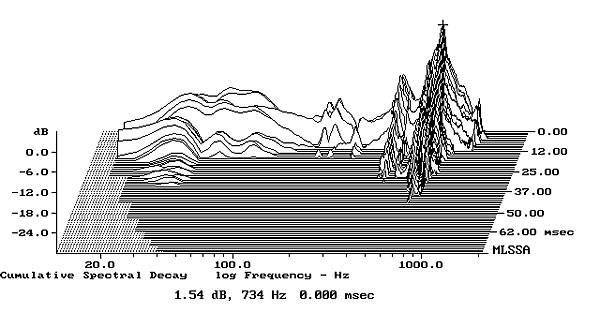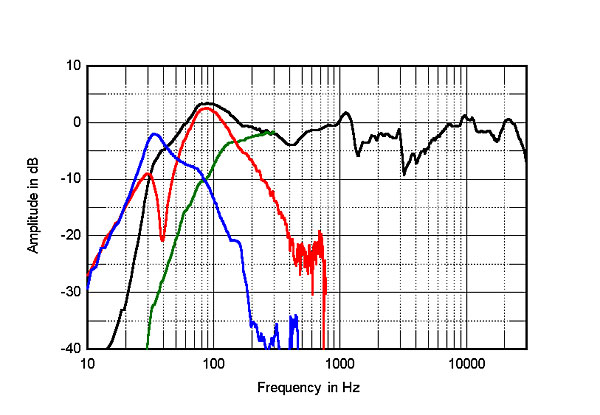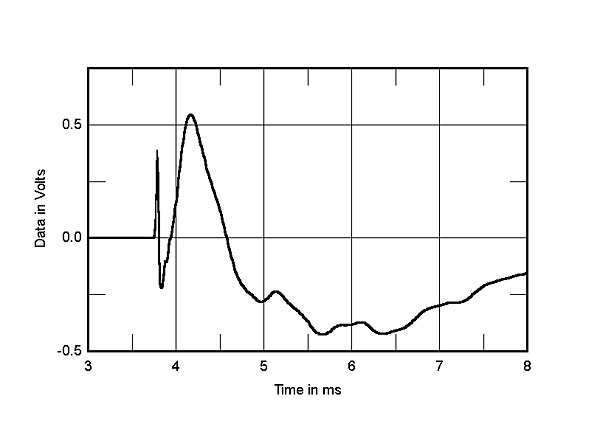| Columns Retired Columns & Blogs |
Vienna Acoustics Beethoven Baby Grand Symphony Edition loudspeaker Measurements
Sidebar 4: Measurements
I used DRA Labs' MLSSA system and a calibrated DPA 4006 microphone to measure the Vienna Acoustics Beethoven Baby Grand SE's frequency response in the farfield, and an Earthworks QTC-40 for the nearfield responses. Vienna Acoustics specifies the Baby Grand's sensitivity as a very high 91dB. My estimate was significantly lower, at 86.5dB(B)/2.83V/m. The impedance is specified as 4 ohms, and while the average magnitude in the midrange and below is indeed 4 ohms, the impedance drops to 2.3 ohms at 90Hz (fig.1, solid trace), a frequency where music has high energy. The impedance also remains above 5.5 ohms for the entire treble region. Fortunately, the electrical phase angle remains relatively benign, but I would still recommend a good 4 ohm–rated amplifier to drive this speaker.

Fig.1 Vienna Acoustics Beethoven Baby Grand SE, electrical impedance (solid) and phase (dashed) (2 ohms/vertical div.).
A discontinuity is visible in the impedance traces around 1.2kHz, but nothing else in the midrange suggests the presence of cabinet panel resonances. However, when I investigated the vibrational behavior of the enclosure's walls with a simple plastic-tape accelerometer (similar to a piezoelectric acoustic-guitar pickup), I found a strong mode at 734Hz that was present over most of the side panels (fig.2), as well as on the baffle between the midrange unit and the upper woofer. Fortunately, this resonance is sufficiently high in frequency that I doubt it would lead to coloration, though it is fair to note that Tom Norton heard some emphasis on piano notes.

Fig.2 Vienna Acoustics Beethoven Baby Grand SE, cumulative spectral-decay plot calculated from output of accelerometer fastened to center of side panel level with upper woofer (MLS driving voltage to speaker, 7.55V; measurement bandwidth, 2kHz).
The saddle between 30 and 40Hz in the impedance-magnitude trace suggests that this is where the single port on the rear panel is tuned, and indeed, the summed output of the woofers (which have identical responses) has the expected minimum-motion notch at 39Hz (fig.3, red trace). The port's output (blue trace), however, peaks slightly lower in frequency, though its upper-frequency rolloff is smooth and free from resonant modes. The crossover from the midrange unit (green trace) appears to occur at the specified 150Hz, with a third-order acoustic rolloff for the midrange driver. This low crossover frequency means that that single unit handles all fundamentals and almost all harmonics of male and female voices and TJN did comment very favorably on how the Beethoven Baby Grand reproduced vocals. The woofers roll off with a second-order slope above their relatively restricted passband of 60–120Hz, and there are no significant resonances in their midrange output. The complex sum of these nearfield outputs (black trace below 300Hz) has a broad peak between 60 and 150Hz, but this will be mainly due to the measurement technique, which assumes a 2pi (hemispherical) loading for the drivers. The low frequencies are down by 6dB at the port tuning frequency of 39Hz. As TJN says, this is still a relatively small floorstander, and should not be expected to offer prodigious amounts of low frequencies.

Fig.3 Vienna Acoustics Beethoven Baby Grand SE, anechoic response on tweeter axis at 50", averaged across 30° horizontal window and corrected for microphone response, with nearfield responses of: midrange unit (green), woofers (blue), port (red), with their complex sum of nearfield responses respectively plotted below 300Hz, 750Hz, 450Hz, 300Hz.
Higher in frequency in fig.3, the midrange unit's output rises to reach a peak just above 1kHz, which is suspiciously close to the frequency of the discontinuity noted in the impedance traces. There is then a disruption in the response trace at 3kHz, above which the tweeter's output is relatively even all the way to 30kHz, the upper limit of this graph. All things being equal, I would have expected the lower-frequency peak to have added a slight nasal coloration. However, while TJN didn't remark on any such coloration, he did write that "female and male voices and solo instruments, in addition to being uncolored, often sounded surprisingly immediate, but without turning edgy or in my face." It is possible, therefore, that the Vienna Acoustics speaker's behavior in the low treble is accentuating detail rather than adding coloration.
The plot of the Beethoven Baby Grand's horizontal dispersion (fig.4) reveals that the suckout between 3 and 5kHz tends to fill in to the speaker's sides (shown by the cursor position), which in a moderately sized room with typical furnishings will make the speaker's treble sound better in balance with the midrange than the on-axis curve suggests. Other than that, the contour lines in this graph are evenly spaced, with the speaker becoming increasingly directional in the top octave, as expected from a 1"-dome tweeter. The plot of the Beethoven's vertical dispersion, referenced to the tweeter-axis response (fig.5), shows that a strong suckout develops at 2.8kHz more than 5° above the tweeter. Don't listen to this speaker while standing. With the speaker on its plinth, the tweeter is 40" from the floor, which is 4" higher than the typical ear height of a seated listener. Fig.5 also reveals, however, that the Baby Grand's response doesn't significantly change up to 10° below the tweeter axis.

Fig.4 Vienna Acoustics Beethoven Baby Grand SE, lateral response family at 50", normalized to response on tweeter axis, from back to front: differences in response 90–5° off axis, reference response, differences in response 5–90° off axis.

Fig.5 Vienna Acoustics Beethoven Baby Grand SE, vertical response family at 50", normalized to response on tweeter axis, from back to front: differences in response 15–5° above axis, reference response, differences in response 5–10° below axis.
The Beethoven Baby Grand's step response on the tweeter axis (fig.6) indicates that its tweeter and midrange unit are connected in positive acoustic polarity, its woofers in inverted polarity. But, as always, what matters more than absolute polarity is how the individual drive-units' steps integrate in the time domain. The Vienna is excellent in this regard, the decay of the tweeter's step smoothly blending with the start of the midrange unit's step, and the decay of that step smoothly blending with the negative-going beginning of the woofers' step. However, some undulations are visible in this graph in fig.6, and the cumulative spectral-decay plot on the tweeter axis (fig.7) shows strong ridges of delayed energy at the frequencies of the treble problems in the frequency-response graph (fig.3). I really don't like to see this behavior, but looking at the in-room response in TJN's "What's Up with Flat?" sidebar, it appears that the higher-frequency resonance doesn't affect the smooth balance of the Baby Grand's treble. And as this resonance is of very high Quality factor (Q), the speaker needs to be reproducing a signal of almost precisely the same frequency to be fully excited.

Fig.6 Vienna Acoustics Beethoven Baby Grand SE, step response on tweeter axis at 50" (5ms time window, 30kHz bandwidth).

Fig.7 Vienna Acoustics Beethoven Baby Grand SE, cumulative spectral-decay plot on tweeter axis at 50" (0.15ms risetime).
Overall, the Vienna Acoustics Beethoven Baby Grand Symphony Edition's measured performance suggests a carefully balanced design, the effects of measured flaws in the midrange unit being reduced by other factors.—John Atkinson
- Log in or register to post comments




































